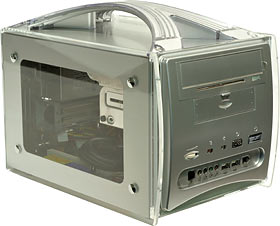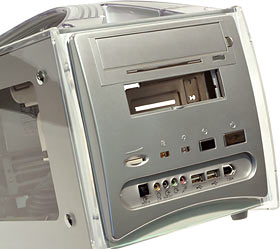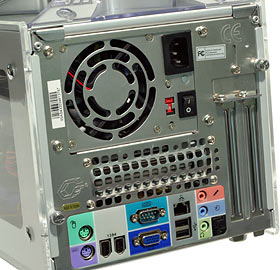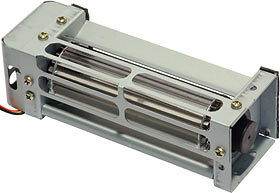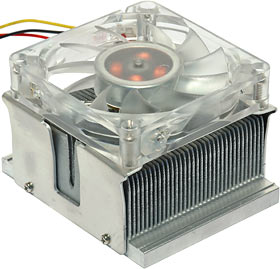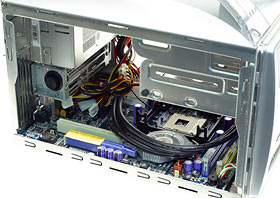
Quick Shot review 20:
Chyang Fun e-Cube CF-EG65A
Review date: 18 February 2004.
Last modified
03-Dec-2011.
The other day, I checked out a Small Form Factor (SFF) PC from the SFF company everyone knows about.
Chyang Fun aren't as well known as Shuttle, but they've been making SFF machines for a while. They made the box I cruelly compared with a plain microATX alternative in this review back in 2002, and they've stuck with that system's acrylic-sided, handle-on-top design for their current "e-Cube" CF-EG65A.
The old Chyang Fun looked good and worked OK; this one's better. Some people managed to crack the handle on the old boxes, so the e-Cube's is stronger. You also get a window in the side, to show off the tight-packed guts of your tiny god. And the chassis is, of course, made from aluminium, not that it'd weigh terribly much even if it were steel.
More importantly, the new box is cheaper than the old one.
Back in the day, the Via P4M266-chipset Chyang Fun mini-box would cost you more than $AU700, even in "bare bones" configuration without CPU, RAM or drives. As I concluded then, this meant that you had to be pretty darn enthused by the SFF concept to go for one of those systems instead of a normal PC.
The EG65A uses the much better Intel i865G chipset (dual channel DDR RAM, support for 800MHz-FSB P4s, partridges, pear trees), but only cost $AU478.50 from Aus PC Market when I first wrote this (Aus PC no longer sell it). That still only buys you the bare bones rig, but you won't save a lot more by buying a regular motherboard and case instead - especially not if you value your time. Buy a barebones SFF box and you need spend no time installing and hooking up the motherboard.
Regular PCs still beat SFF in the expansion slot and drive bay stakes, of course. But if you don't need the space - and most people don't - you really might as well go SFF these days.
Anyway - back to the guided tour of the e-Cube.
The e-Cube's got the usual three-drive-bay SFF layout. One externally accessible 5.25 inch bay, one externally accessible 3.5 inch, one internal 3.5.
Both external bays are "stealthed"; the 3.5 incher has a sliding cover (open in the above picture), and the 5.25 incher has a spring-loaded plastic cover like unto the prettier aluminium Lian Li ones I check out here.
In these days of standardised drive front panel layouts, when most people have little need to be able to access drive-front volume controls and headphone jacks, there's a decent chance the cover will fit the beige drive of your choice. If it doesn't, you can easily pop it out and install the drive normally.
When the e-Cube's powered up, by the way, the clear panel behind the silver plastic front bezel lights up blue. There's a thumbwheel volume control on the front panel, too.
Oddly, the e-Cube's 5.1 channel audio outputs (surround sound courtesy of the popular Realtek ALC650) are all on the front panel, along with a mic-in socket. This is good for quick temporary hookups, but it's a bit inelegant if you want to connect stuff to these sockets permanently.
The back panel of the e-Cube has the analogue audio inputs (including a second microphone input), and the headphone output socket.
(No, you can't just swap some plugs on the motherboard to swap the rear and front audio connectors - the rear ones are soldered onto the motherboard.)
In the "other stuff you expect" category, there's a 10/100BaseT network jack, two USB and two FireWire ports (two more USB and one FireWire live on the front panel), a serial port, the standard monitor connector, and PS/2 keyboard and mouse ports, plus the normal IEC power receptacle. In the "stuff we've come to expect" category, there's an optical digital S/PDIF audio output (S/PDIF input's on the front panel).
Two expansion slots, thumbscrews retaining the side panels; normal. As well as the PSU's exhaust fan, though, there's...
...this. It's a crossflow blower, and it moves a respectable amount of air out of the back of the case without making much noise at all.
The e-Cube's still definitely not a silent PC, but the two fans together don't make it any louder than a lot of systems with nothing but a standard ATX PSU.
Ventilation is a weak point of many SFF systems; they may be able to accept a 3GHz P4, but it's not necessarily a good idea to put one in there. This box ought to be OK with it, though.
The reason why you don't see blowers like this in all kinds of cases is that they have to be quite long, like this one, to get decent air flow without ludicrous rotational speed (and noise). A regular rotary fan that takes up less real estate on the back panel can move just as much air, and the noise difference isn't usually big enough to be important.
The e-Cube's CPU cooler's less exciting than its exhaust fan. It ought to get the job done well enough, though; skived-fin aluminium coolers like this always work well.
And yes, that low-power slimline fan does have LED lights in it. Well, there's a window in the side of the e-Cube. So of course it does.
Inside the e-Cube is an unremarkable SFF layout, with enough space that anyone with normal-sized hands should be able to install hardware without losing their minds. There aren't any super-cool Shuttle-style pre-routed cables for drives, and a few tall smoothing capacitors could get themselves bent by klutzy workers, but no serious pitfalls await.
The only surprise is the presence of a pair of Serial ATA (SATA) drive connectors (to each of which you can connect one drive), on top of the two standard Parallel ATA (PATA) connectors (good for two drives each).
SATA drives cost a bit more than PATA but aren't any faster, and it's not as if you can even install four drives in a box like this, and the e-Cube comes with rounded PATA cables so there's not much of an airflow or cable routing benefit to SATA. But if SATA matters to you, the e-Cube's got it.
The cooler on the e-Cube's i865 north bridge chip, by the way, has another clear plastic fan - but this one doesn't light up. Just so you know.
As is usual for two-slot SFF systems, the e-Cube gives you one PCI slot and one AGP. You don't have to install any cards if you don't want to, but you're going to need an AGP graphics card if you're interested in 3D.
The i865G's integrated video adapter emits what Intel bravely call "Extreme Graphics 2". For 2D, this adapter's more than adequate - so's every other current graphics adapter. For 3D, though, i865G sucks wind.
The plus side of i865G integrated video is that it pretty much comes free with the chipset. The integrated-graphics version of the i865 costs very little more than the no-video version, and the extra mobo tracks and HD15 monitor connector don't jack the price up that much either. This is why you'll find i865G in a lot of SFF boxes these days, including several Shuttles (including one I checked out here).
The e-Cube's relatively beefy 220 watt PSU should have no trouble running even quite hefty AGP cards. Old high-wattage GeForces might not be a great idea unless you match them with a nice gentle Celeron, and the very screamingest FlowFX-cooled GeForce FXes might tax the PSU a bit too (actually, since the AGP slot's the one closest to the edge of the motherboard, double-width cards like the FlowFX ones wouldn't actually fit without modification and removal of the side panel...), but you ought to be right as rain with a less silly GeForce Whatever, or the Radeon of your choice.
Overall
The e-Cube's only real problem is that its decorative frills make it more expensive. When I first wrote this, a Shuttle SB61G2, with much the same feature set as the e-Cube, only set you back $AU412.50 from Aus PC Market, again including Sydney metro delivery. The e-Cube's $AU66 more expensive, and doesn't really give you anything more but show-off value. Aus PC no longer sell these products, but click here to see their current case-related products.
If you dig the looks of the e-Cube, though, the extra money could well be worth it. $AU66 ain't much compared with the price of a whole SFF system (over $AU1000, unless you really skimp), and the e-Cube gives nothing else away to the Shuttle. It's based on the same solid chipset, it's got ticks in all of the usual boxes, and it does look funky.
The e-Cube isn't the SFF box to choose for the reception desk at a funeral home, but it'd pass muster in less staid offices, even if you use the space for LAN parties on the weekend. I like it, and I think many of you, gentle readers, will too.
Buy stuff!
Aus PC Market doesn't sell
this case any more -
click
here to see their current case-related products!
